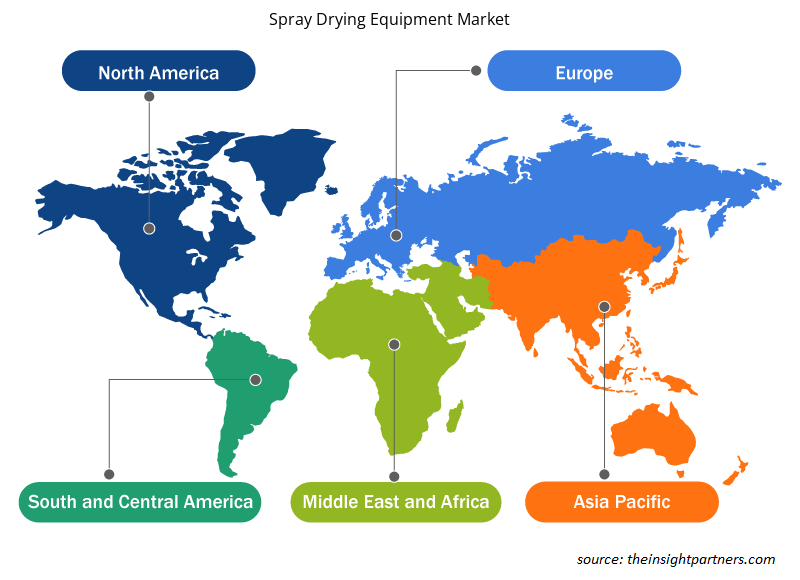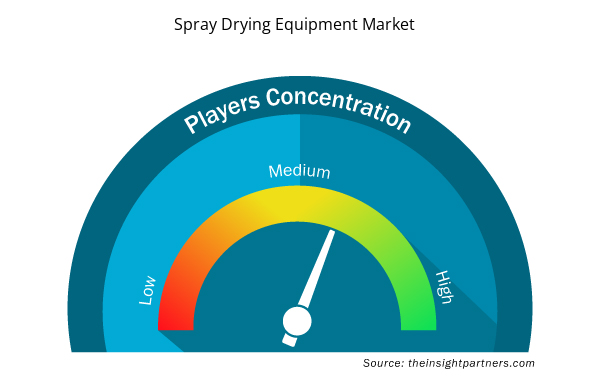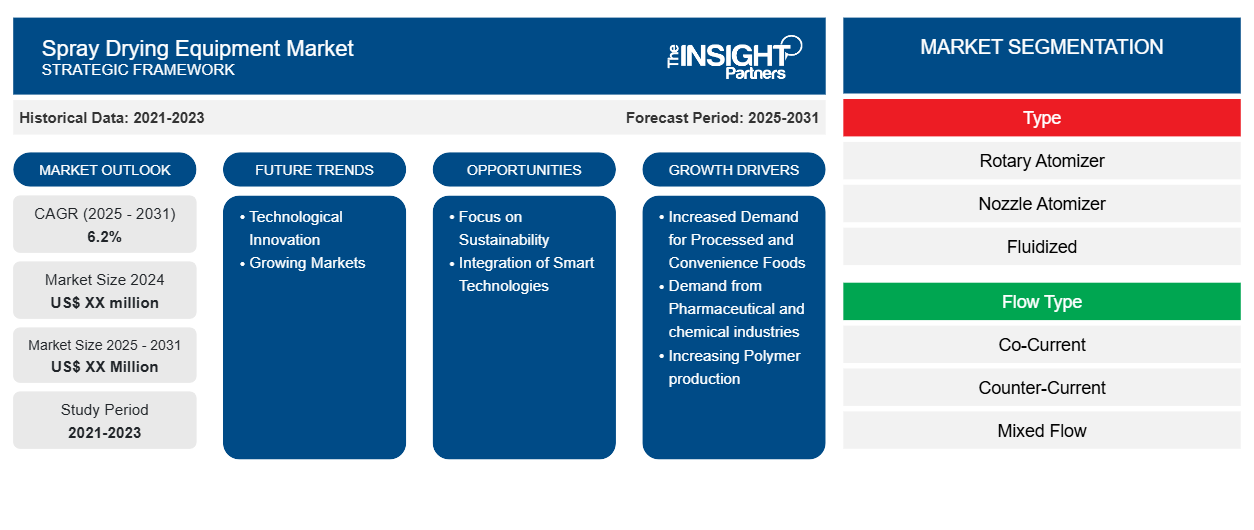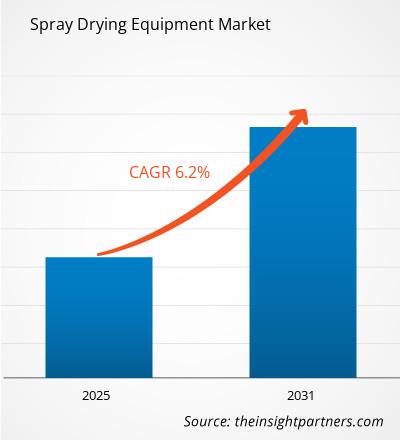Der Markt für Sprühtrocknungsgeräte wird voraussichtlich von 2023 bis 2031 eine durchschnittliche jährliche Wachstumsrate (CAGR) von 6,2 % verzeichnen, wobei die Marktgröße von XX Millionen US-Dollar im Jahr 2023 auf XX Millionen US-Dollar im Jahr 2031 wachsen wird.
Der Bericht ist nach Typ (Rotationszerstäuber, Düsenzerstäuber, Fluidisiert, Geschlossener Kreislauf, Zentrifugal und Sonstige) segmentiert. Der Bericht enthält außerdem Analysen basierend auf dem Strömungstyp (Gleichstrom, Gegenstrom und Mischstrom). Der Bericht enthält außerdem Analysen basierend auf dem Zyklustyp (Offener Zyklus und Geschlossener Zyklus). Der Bericht enthält außerdem Analysen basierend auf der Trocknungsstufe (Einstufig und Mehrstufig). Der Bericht enthält außerdem Analysen basierend auf dem Endverbraucher (Pharmazeutika, Chemie, Lebensmittel und Milchprodukte und Sonstige). Die globale Analyse ist weiter auf regionaler Ebene und in die wichtigsten Länder unterteilt. Der Bericht bietet den Wert in USD für die oben genannten Analysen und Segmente.
Zweck des Berichts
Der Bericht „Sprühtrocknungsgerätemarkt“ von The Insight Partners zielt darauf ab, die gegenwärtige Landschaft und das zukünftige Wachstum sowie die wichtigsten treibenden Faktoren, Herausforderungen und Chancen zu beschreiben. Dies wird verschiedenen Geschäftspartnern Einblicke geben, wie zum Beispiel:
- Technologieanbieter/-hersteller: Um die sich entwickelnde Marktdynamik zu verstehen und die potenziellen Wachstumschancen zu kennen, damit sie fundierte strategische Entscheidungen treffen können.
- Investoren: Durchführung einer umfassenden Trendanalyse hinsichtlich der Marktwachstumsrate, der finanziellen Marktprognosen und der Chancen entlang der Wertschöpfungskette.
- Regulierungsbehörden: Zur Regulierung von Richtlinien und Überwachungsaktivitäten auf dem Markt mit dem Ziel, Missbrauch zu minimieren, das Vertrauen der Anleger zu bewahren und die Integrität und Stabilität des Marktes aufrechtzuerhalten.
Marktsegmentierung für Sprühtrocknungsgeräte
Typ
- Rotationszerstäuber
- Düsenzerstäuber
- Verflüssigt
- Geschlossener Kreislauf
- Zentrifugal
- Sonstiges
Durchflussart
- Gleichstrom
- Gegenstrom
- Gemischter Durchfluss
Zyklustyp
- Offener Kreislauf und geschlossener Kreislauf
Trocknungsphase
- Einstufig und mehrstufig
Trocknungsphase
- Einstufig und mehrstufig
Passen Sie diesen Bericht Ihren Anforderungen an
Sie erhalten kostenlos individuelle Anpassungen an jedem Bericht, einschließlich Teilen dieses Berichts oder einer Analyse auf Länderebene, eines Excel-Datenpakets sowie tolle Angebote und Rabatte für Start-ups und Universitäten.
- Holen Sie sich die wichtigsten Markttrends aus diesem Bericht.Dieses KOSTENLOSE Beispiel umfasst eine Datenanalyse von Markttrends bis hin zu Schätzungen und Prognosen.
Wachstumstreiber auf dem Markt für Sprühtrocknungsgeräte
- Erhöhte Nachfrage nach Fertiggerichten und Convenience-Food: Die steigende Nachfrage nach Fertiggerichten in Form von verpackten, haltbaren Fertiggerichten treibt das Wachstum des Marktes für Sprühtrocknungsanlagen voran. Um die Umwandlung flüssiger Zutaten in Trockenpulver durch Sprühtrocknung besser zu nutzen, müssen Hersteller die Haltbarkeitsdauer verlängern und die Qualität der Lebensmittel verbessern. Dieser Trend ist insbesondere in der Lebensmittel- und Getränkeindustrie sehr ausgeprägt, wo eine wachsende Nachfrage nach Convenience-Food besteht.
- Nachfrage aus der Pharma- und Chemieindustrie: Die Pharma- und Chemieindustrie wächst relativ stark und die Nachfrage nach Sprühtrocknungsanlagen ist beträchtlich. Dies liegt daran, dass die Anwendung dieser Technologie zur Herstellung von Trockenpulver aus flüssigen Formulierungen ein für zahlreiche Anwendungen, wie Arzneimittelverabreichungssysteme und chemische Verarbeitung, entscheidender Prozess ist. Mit dem Wachstum dieser Branchen steigt auch die Nachfrage nach effizienten und zuverlässigen Trocknungslösungen.
- Steigende Polymerproduktion: Polymere werden zur Herstellung von Nanopartikeln und Mikrokugeln verwendet, die in verschiedenen Anwendungen wie Kunststoffen, synthetischen Fasern und Elastomeren zum Einsatz kommen. Die steigende Nachfrage nach Polymeren treibt den Markt für Sprühtrocknungsgeräte weiter an. Kunststoffe für Bauwesen, Verpackung und Elektronik sowie synthetische Fasern für Industrietextilien und Teppiche, gefolgt von Elastomeren für Gummibänder, Dichtungen und Reifen, treiben die Nachfrage nach Sprühtrocknungsgeräten weiter an.
Zukünftige Trends auf dem Markt für Sprühtrocknungsgeräte
- Technologische Innovation: Die Wachstumschancen durch technologische Innovation können auf dem Markt für Sprühtrocknungsanlagen genutzt werden. Einige dieser Innovationen umfassen ein energieeffizientes System, verbesserte Trocknungstechniken und Automatisierung, die die Gesamtleistung verbessern, aber auch die Betriebskosten der Sprühtrockner senken. Durch Forschungs- und Entwicklungsanstrengungen der Unternehmen kann mit besseren Alternativen ein größerer Marktanteil erreicht werden.
- Wachsende Märkte: Schwellenmärkte bieten weiterhin eine wichtige Gelegenheit für die Expansion von Sprühtrocknungsanlagen. Aufgrund der Industrialisierung und Urbanisierung wird die Nachfrage nach fortschrittlichen Trocknungstechnologien für Anwendungen in Branchen wie der Lebensmittelverarbeitung, Pharmazie und Chemie in Regionen wie dem asiatisch-pazifischen Raum und Lateinamerika steigen. Hier bieten sich Chancen für Unternehmen, die ihre Produkte an spezifische Marktanforderungen anpassen.
Marktchancen für Sprühtrocknungsgeräte
- Fokus auf Nachhaltigkeit: Nachhaltigkeit ist das Muster auf dem Markt für Sprühtrocknungsanlagen. Die meisten Unternehmen bauen heute Trockner, die umweltfreundlicher, weniger energieintensiv und ressourcenschonender sind. Dieser Ansatz zielt darauf ab, die Arbeit nachhaltig zu gestalten, und dies wird die Kaufentscheidungen umweltbewusster Unternehmen beeinflussen.
- Integration intelligenter Technologien: Intelligente Technologien und IoT werden zunehmend in Sprühtrocknungsanlagen integriert. Diese ermöglichen die Online-Überwachung und Echtzeitsteuerung des Trocknungsprozesses, was zu höherer Effizienz und geringeren Ausfallzeiten führt. Mit der zunehmenden Einführung intelligenter Fertigungsverfahren in der Industrie wird daher die Nachfrage nach vernetzten und intelligenten Sprühtrocknungssystemen steigen.
Regionale Einblicke in den Markt für Sprühtrocknungsgeräte
Die regionalen Trends und Faktoren, die den Markt für Sprühtrocknungsanlagen im Prognosezeitraum beeinflussen, wurden von den Analysten von Insight Partners ausführlich erläutert. In diesem Abschnitt werden auch die Marktsegmente und die Geografie von Sprühtrocknungsanlagen in Nordamerika, Europa, im asiatisch-pazifischen Raum, im Nahen Osten und Afrika sowie in Süd- und Mittelamerika erörtert.

- Erhalten Sie regionale Daten zum Markt für Sprühtrocknungsgeräte
Umfang des Marktberichts über Sprühtrocknungsgeräte
| Berichtsattribut | Details |
|---|---|
| Marktgröße im Jahr 2023 | XX Millionen US-Dollar |
| Marktgröße bis 2031 | XX Millionen US-Dollar |
| Globale CAGR (2023 - 2031) | 6,2 % |
| Historische Daten | 2021-2022 |
| Prognosezeitraum | 2024–2031 |
| Abgedeckte Segmente | Nach Typ
|
| Abgedeckte Regionen und Länder | Nordamerika
|
| Marktführer und wichtige Unternehmensprofile |
|
Dichte der Marktteilnehmer für Sprühtrocknungsanlagen: Auswirkungen auf die Geschäftsdynamik verstehen
Der Markt für Sprühtrocknungsgeräte wächst rasant, angetrieben durch die steigende Nachfrage der Endverbraucher aufgrund von Faktoren wie sich entwickelnden Verbraucherpräferenzen, technologischen Fortschritten und einem größeren Bewusstsein für die Vorteile des Produkts. Mit steigender Nachfrage erweitern Unternehmen ihr Angebot, entwickeln Innovationen, um die Bedürfnisse der Verbraucher zu erfüllen, und nutzen neue Trends, was das Marktwachstum weiter ankurbelt.
Die Marktteilnehmerdichte bezieht sich auf die Verteilung der Firmen oder Unternehmen, die in einem bestimmten Markt oder einer bestimmten Branche tätig sind. Sie gibt an, wie viele Wettbewerber (Marktteilnehmer) in einem bestimmten Marktraum im Verhältnis zu seiner Größe oder seinem gesamten Marktwert präsent sind.
Die wichtigsten auf dem Markt für Sprühtrocknungsgeräte tätigen Unternehmen sind:
- Dedert Corporation
- Europäische SprayDry-Technologien
- GEA Group
- Shandong Shungeng Trocknungsausrüstung Co., Ltd.
- Shanghai Jiadi Machinery Co. Ltd
Haftungsausschluss : Die oben aufgeführten Unternehmen sind nicht in einer bestimmten Reihenfolge aufgeführt.

- Überblick über die wichtigsten Akteure auf dem Markt für Sprühtrocknungsgeräte
Wichtige Verkaufsargumente
- Umfassende Abdeckung: Der Bericht deckt die Analyse von Produkten, Dienstleistungen, Typen und Endbenutzern des Sprühtrocknungsgeräte-Marktes umfassend ab und bietet einen ganzheitlichen Überblick.
- Expertenanalyse: Der Bericht basiert auf dem umfassenden Verständnis von Branchenexperten und Analysten.
- Aktuelle Informationen: Der Bericht stellt durch die Abdeckung aktueller Informationen und Datentrends Geschäftsrelevanz sicher.
- Anpassungsoptionen: Dieser Bericht kann angepasst werden, um spezifische Kundenanforderungen zu erfüllen und die Geschäftsstrategien optimal anzupassen.
Der Forschungsbericht zum Markt für Sprühtrocknungsanlagen kann daher dabei helfen, die Branchensituation und Wachstumsaussichten zu entschlüsseln und zu verstehen. Obwohl es einige berechtigte Bedenken geben kann, überwiegen die allgemeinen Vorteile dieses Berichts tendenziell die Nachteile.
- Historische Analyse (2 Jahre), Basisjahr, Prognose (7 Jahre) mit CAGR
- PEST- und SWOT-Analyse
- Marktgröße Wert/Volumen – Global, Regional, Land
- Branche und Wettbewerbsumfeld
- Excel-Datensatz


- Advanced Planning and Scheduling Software Market
- Organoids Market
- Battery Testing Equipment Market
- Rugged Phones Market
- Lyophilization Services for Biopharmaceuticals Market
- Fishing Equipment Market
- Skin Tightening Market
- Cling Films Market
- Artificial Intelligence in Defense Market
- Passport Reader Market

Report Coverage
Revenue forecast, Company Analysis, Industry landscape, Growth factors, and Trends

Segment Covered
This text is related
to segments covered.

Regional Scope
North America, Europe, Asia Pacific, Middle East & Africa, South & Central America

Country Scope
This text is related
to country scope.
Häufig gestellte Fragen
Some of the customization options available based on the request are an additional 3-5 company profiles and country-specific analysis of 3-5 countries of your choice. Customizations are to be requested/discussed before making final order confirmation, as our team would review the same and check the feasibility.
The report can be delivered in PDF/PPT format; we can also share excel dataset based on the request.
The leading players operating in the Spray Drying Equipment Market include Dedert Corporation, European SprayDry Technologies, GEA Group, Shandong Shungeng Drying Equipment Co., Ltd., Shanghai Jiadi Machinery Co. Ltd, SPX FLOW, Swenson Technology, Inc., Tetra Pak, Transparent Technologies Pvt. Ltd, Yamato Scientific America Inc.
Focus on Sustainability and Integration of Smart Technologies are the key future trends of the Spray Drying Equipment Market
The Spray Drying Equipment Market is estimated to witness a CAGR of 6.2% from 2023 to 2031
The major factors driving the Spray Drying Equipment Market are: Increased Demand for Processed and Convenience Foods and Pharmaceutical and chemical
Trends and growth analysis reports related to Manufacturing and Construction : READ MORE..
The List of Companies
- Dedert Corporation
- European SprayDry Technologies
- GEA Group
- Shandong Shungeng Drying Equipment Co., Ltd.
- Shanghai Jiadi Machinery Co. Ltd
- SPX FLOW
- Swenson Technology, Inc.
- Tetra Pak
- Transparent Technologies Pvt. Ltd
- Yamato Scientific America Inc.
The Insight Partners performs research in 4 major stages: Data Collection & Secondary Research, Primary Research, Data Analysis and Data Triangulation & Final Review.
- Data Collection and Secondary Research:
As a market research and consulting firm operating from a decade, we have published and advised several client across the globe. First step for any study will start with an assessment of currently available data and insights from existing reports. Further, historical and current market information is collected from Investor Presentations, Annual Reports, SEC Filings, etc., and other information related to company’s performance and market positioning are gathered from Paid Databases (Factiva, Hoovers, and Reuters) and various other publications available in public domain.
Several associations trade associates, technical forums, institutes, societies and organization are accessed to gain technical as well as market related insights through their publications such as research papers, blogs and press releases related to the studies are referred to get cues about the market. Further, white papers, journals, magazines, and other news articles published in last 3 years are scrutinized and analyzed to understand the current market trends.
- Primary Research:
The primarily interview analysis comprise of data obtained from industry participants interview and answers to survey questions gathered by in-house primary team.
For primary research, interviews are conducted with industry experts/CEOs/Marketing Managers/VPs/Subject Matter Experts from both demand and supply side to get a 360-degree view of the market. The primary team conducts several interviews based on the complexity of the markets to understand the various market trends and dynamics which makes research more credible and precise.
A typical research interview fulfils the following functions:
- Provides first-hand information on the market size, market trends, growth trends, competitive landscape, and outlook
- Validates and strengthens in-house secondary research findings
- Develops the analysis team’s expertise and market understanding
Primary research involves email interactions and telephone interviews for each market, category, segment, and sub-segment across geographies. The participants who typically take part in such a process include, but are not limited to:
- Industry participants: VPs, business development managers, market intelligence managers and national sales managers
- Outside experts: Valuation experts, research analysts and key opinion leaders specializing in the electronics and semiconductor industry.
Below is the breakup of our primary respondents by company, designation, and region:

Once we receive the confirmation from primary research sources or primary respondents, we finalize the base year market estimation and forecast the data as per the macroeconomic and microeconomic factors assessed during data collection.
- Data Analysis:
Once data is validated through both secondary as well as primary respondents, we finalize the market estimations by hypothesis formulation and factor analysis at regional and country level.
- Macro-Economic Factor Analysis:
We analyse macroeconomic indicators such the gross domestic product (GDP), increase in the demand for goods and services across industries, technological advancement, regional economic growth, governmental policies, the influence of COVID-19, PEST analysis, and other aspects. This analysis aids in setting benchmarks for various nations/regions and approximating market splits. Additionally, the general trend of the aforementioned components aid in determining the market's development possibilities.
- Country Level Data:
Various factors that are especially aligned to the country are taken into account to determine the market size for a certain area and country, including the presence of vendors, such as headquarters and offices, the country's GDP, demand patterns, and industry growth. To comprehend the market dynamics for the nation, a number of growth variables, inhibitors, application areas, and current market trends are researched. The aforementioned elements aid in determining the country's overall market's growth potential.
- Company Profile:
The “Table of Contents” is formulated by listing and analyzing more than 25 - 30 companies operating in the market ecosystem across geographies. However, we profile only 10 companies as a standard practice in our syndicate reports. These 10 companies comprise leading, emerging, and regional players. Nonetheless, our analysis is not restricted to the 10 listed companies, we also analyze other companies present in the market to develop a holistic view and understand the prevailing trends. The “Company Profiles” section in the report covers key facts, business description, products & services, financial information, SWOT analysis, and key developments. The financial information presented is extracted from the annual reports and official documents of the publicly listed companies. Upon collecting the information for the sections of respective companies, we verify them via various primary sources and then compile the data in respective company profiles. The company level information helps us in deriving the base number as well as in forecasting the market size.
- Developing Base Number:
Aggregation of sales statistics (2020-2022) and macro-economic factor, and other secondary and primary research insights are utilized to arrive at base number and related market shares for 2022. The data gaps are identified in this step and relevant market data is analyzed, collected from paid primary interviews or databases. On finalizing the base year market size, forecasts are developed on the basis of macro-economic, industry and market growth factors and company level analysis.
- Data Triangulation and Final Review:
The market findings and base year market size calculations are validated from supply as well as demand side. Demand side validations are based on macro-economic factor analysis and benchmarks for respective regions and countries. In case of supply side validations, revenues of major companies are estimated (in case not available) based on industry benchmark, approximate number of employees, product portfolio, and primary interviews revenues are gathered. Further revenue from target product/service segment is assessed to avoid overshooting of market statistics. In case of heavy deviations between supply and demand side values, all thes steps are repeated to achieve synchronization.
We follow an iterative model, wherein we share our research findings with Subject Matter Experts (SME’s) and Key Opinion Leaders (KOLs) until consensus view of the market is not formulated – this model negates any drastic deviation in the opinions of experts. Only validated and universally acceptable research findings are quoted in our reports.
We have important check points that we use to validate our research findings – which we call – data triangulation, where we validate the information, we generate from secondary sources with primary interviews and then we re-validate with our internal data bases and Subject matter experts. This comprehensive model enables us to deliver high quality, reliable data in shortest possible time.


 Holen Sie sich ein kostenloses Muster für diesen Bericht
Holen Sie sich ein kostenloses Muster für diesen Bericht